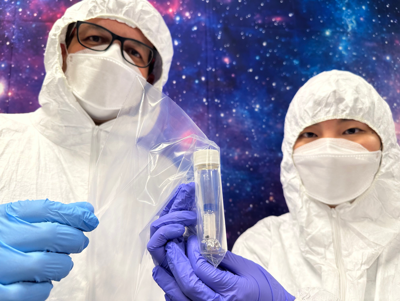The Field Museum unveiled a tiny rock sample from the asteroid Bennu, capping a mission more than 20 years in the making. The arrival gives museum scientists their first opportunity to study an extraterrestrial specimen uncontaminated by Earth’s atmosphere or microbes.
According to a press release, Bennu—the focus of NASA’s 2016 OSIRIS-REx mission—is classified as a near-Earth asteroid, one of roughly 1 million such objects orbiting close to our planet. At about 1,450 feet tall, comparable to the Willis Tower, Bennu is less a solid body than a loose agglomeration of space rocks held together by gravity.
Scientists believe Bennu formed some 4.6 billion years ago in the distant, icy reaches beyond Neptune and has remained largely unchanged, the press release states. Today, it shares a sun-orbit similar to Earth’s, making it an ideal subject for probing the organic minerals present when the Solar System first assembled.
“The compounds in these rocks came to Earth before life formed and they were part of the building blocks of life, but were not formed by life,” said Dr. Philipp Heck, head of the Robert A. Pritzker Curator of Meteoritics and Polar Studies and senior director of the Negaunee Integrative Research Center at the Field Museum in their press release. “We are still trying to quantify how much material came from space to Earth to make life possible. We want to know where we came from, and this is part of our origin story.”
Unlike meteorite fragments that survive fiery descents through Earth’s atmosphere, the Bennu sample has never been exposed to terrestrial weathering, air, or microbial life. That pristine state will allow researchers to distinguish intrinsic asteroid properties from those introduced after landing.
Yuke Zheng, a University of Chicago graduate student and member of the OSIRIS-REx Sample Analysis Team, has spent the past two years comparing carbon-rich meteorites at the Field. “It’s like a puzzle,” she said. “This sample of Bennu is the last piece.”
The museum’s event on Wednesday, June 11, at 1400 S. DuSable Lake Shore Drive will include a brief ceremony and remarks by Field Museum leadership and OSIRIS-REx scientists. Following the public presentation, the asteroid fragment will be transferred to the Negaunee Integrative Research Center’s clean labs, where coordinated studies with partner institutions will begin immediately.
This sample promises new insights into the minerals and organic compounds that existed during the Solar System’s infancy and, perhaps, into the very ingredients that made life on Earth possible.








(0) comments
Welcome to the discussion.
Log In
Keep it Clean. Please avoid obscene, vulgar, lewd, racist or sexually-oriented language.
PLEASE TURN OFF YOUR CAPS LOCK.
Don't Threaten. Threats of harming another person will not be tolerated.
Be Truthful. Don't knowingly lie about anyone or anything.
Be Nice. No racism, sexism or any sort of -ism that is degrading to another person.
Be Proactive. Use the 'Report' link on each comment to let us know of abusive posts.
Share with Us. We'd love to hear eyewitness accounts, the history behind an article.